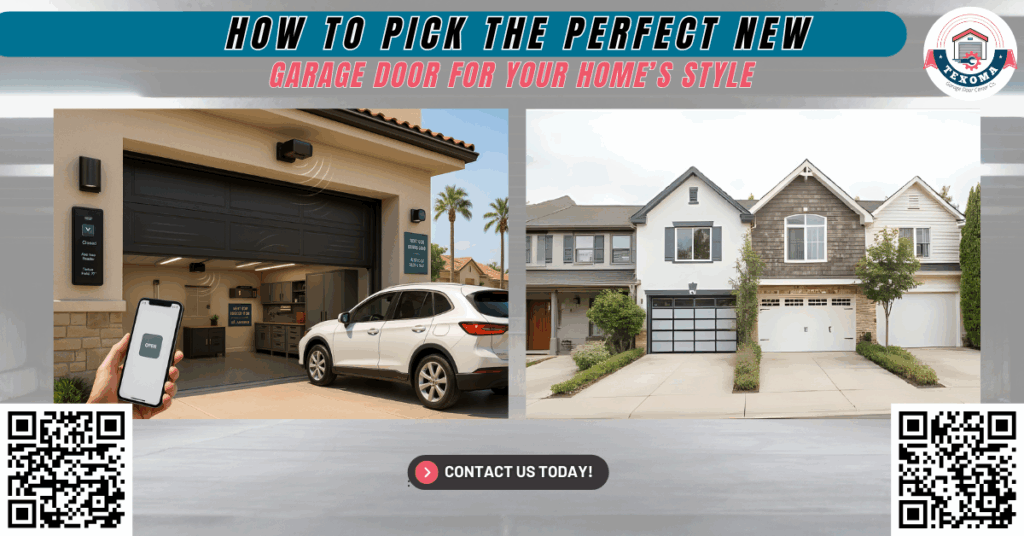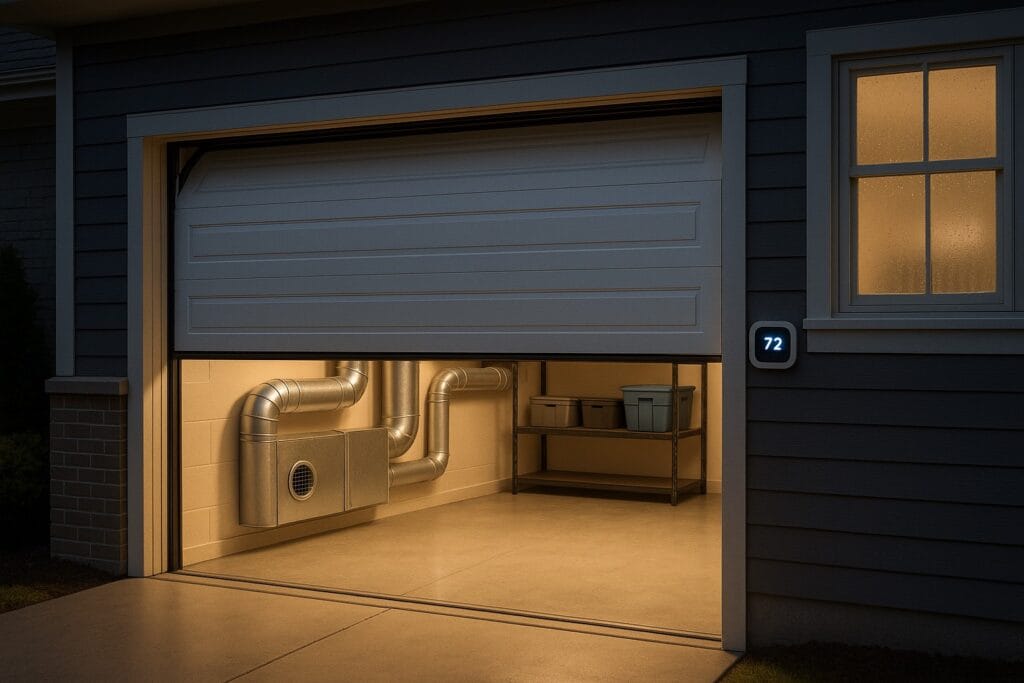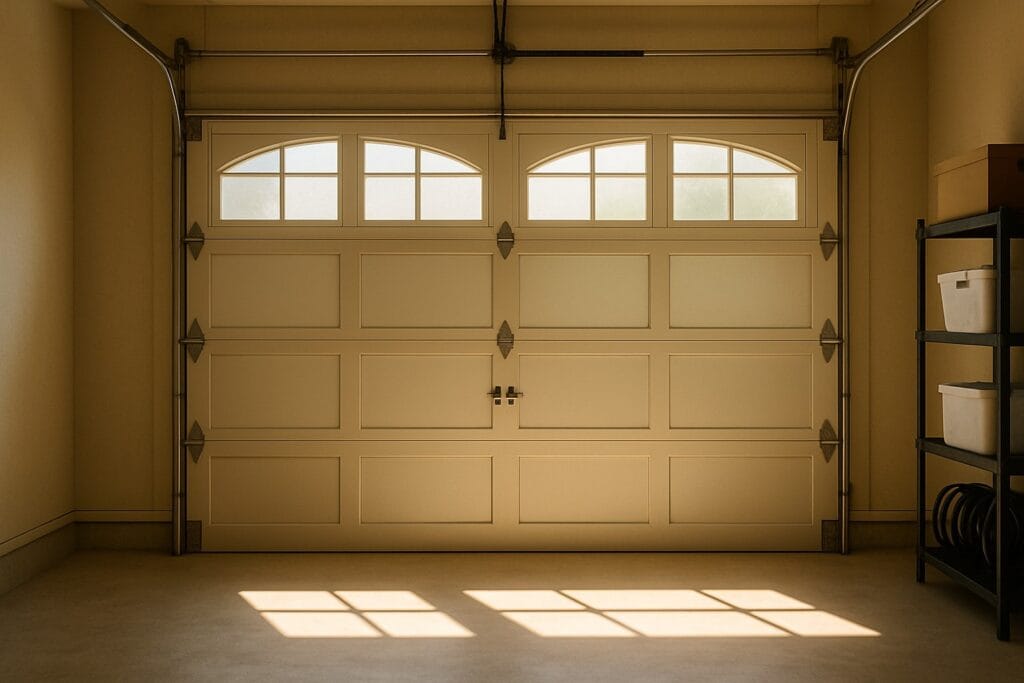How to Pick the Perfect New Garage Door for Your Home’s Style

When one of our clients, David O’Mara, contacted Texoma Garage Door Center Co. about replacing the aging wooden garage doors on his Sherman, TX property, he wasn’t just concerned about function, he wanted to boost his home’s curb appeal, improve insulation for better energy efficiency, and upgrade security with smart garage door features. After a personalized consultation, we installed a beautiful craftsman-style steel door with decorative hardware, high R-value insulation, and a Wi-Fi-enabled belt drive garage door opener. Not only did David see a noticeable reduction in utility bills during the cold weather months, but neighbors frequently complimented his home’s refreshed appearance.
This experience isn’t unique. According to Remodeling Magazine’s 2024 Cost vs. Value Report, garage door replacement has one of the highest returns on investment (ROI) of any home improvement project, up to 94.5% nationwide. Your garage door is more than just a functional necessity; it’s a key design element, security barrier, and energy buffer for your home. Choosing the right one affects everything from safety to style. It represents a significant visual and practical part of your property that is used multiple times every day by most homeowners.
At Texoma Garage Door Center Co., we provide professional installation, repair, and garage door replacement services for both residential and commercial clients. In this comprehensive guide, we’ll help you understand the most important factors to consider when buying a new garage door so you can make the right choice for your home, style, and budget. Our goal is to provide a complete, easy-to-understand resource that empowers you to make informed decisions that match your unique needs.
Why Replacing Your Garage Door Matters
A garage door is often the largest moving structure on your property. It sees daily use and is crucial for security, insulation, and design. Over time, older garage doors may warp, delaminate, or sag due to years of exposure to weather, lack of maintenance, or outdated materials. When springs fail or openers wear out, it can compromise your family’s safety and your home’s accessibility. Routine inspections by professionals can prevent emergencies, but there comes a time when replacement is a smarter long-term investment.
Replacing your garage door can transform your home’s exterior, especially when you consider that garage doors account for up to 30% of your front-facing façade. A stylish carriage house or craftsman garage door design can significantly enhance curb appeal. This can be especially impactful if you’re planning to sell your home soon. Many potential buyers view the garage door as a reflection of the home’s overall condition.
Functionally, a new garage door with upgraded insulation helps stabilize indoor temperatures, making your garage more comfortable while reducing heating and cooling costs. In places like Sherman, where summers are hot and winters can dip into chilly temperatures, this added insulation can make a substantial difference. It also improves soundproofing, which is a bonus for homes near busy roads or with garages used as workshops or gyms.

Whether you’re renovating, flipping a house, or simply upgrading, a garage door replacement is one of the most impactful and cost-effective projects. Homeowners who invest in a new door also benefit from modern safety features, improved durability, and lower maintenance requirements. Many newer models offer lifetime warranties on key components, providing peace of mind for years to come.
Types of Garage Doors to Consider
Understanding the different garage door styles and how they function can help you choose a door that suits both your practical and aesthetic needs. Each type has unique features that offer varying levels of insulation, security, style, and space-saving advantages.
1. Sectional Garage Doors
These are the most common types in residential settings. Sectional doors are made of panel sections connected with hinges and roll vertically on tracks. They are space-efficient, compatible with most garage door openers, and offer excellent insulation when fitted with foam core materials like polyurethane. Sectional garage doors are available in steel, wood, composite, and aluminum finishes, making them versatile and cost-effective.
2. Roll-Up Doors
Typically used in commercial garages or storage units, roll-up doors consist of narrow slats that roll into a coil above the garage opening. They are incredibly durable and low-maintenance, designed to withstand heavy daily use. While not commonly used in homes, roll-up doors may be ideal for garages with limited ceiling space or unique structural needs.
3. Carriage House Doors
Carriage house (or swing-out style) garage doors mimic the look of historic French doors but open upward using modern track and torsion spring systems. Often chosen for their rustic charm, these doors are perfect for craftsman- and farmhouse-style homes. They can be customized with wood or steel materials, decorative hinges, and smart openers.
4. Slide-to-Side Doors
As the name suggests, these doors bend to one side and slide along the garage wall. They are ideal for garages with low ceilings or obstructions that prevent vertical movement. Though less common, slide-to-side doors offer unique visual appeal and ease of pedestrian access.
5. Side-Hinged Doors
Resembling large barn doors, side-hinged doors swing open from a hinged frame. They’re often made of wood or composite and appeal to those looking for traditional aesthetics. However, they require more clearance space and are better suited to detached garages or garages with limited overhead clearance.
Choosing the Right Garage Door Material
The material of your garage door greatly impacts performance, maintenance, appearance, and cost. Let’s break down your top options and how they apply to different homes and usage needs.
1. Steel Doors
Steel garage doors are among the most popular due to their strength, affordability, and minimal maintenance. They resist warping, cracking, and rust when treated with protective finishes. Steel doors are available in single-, double-, or triple-layer constructions, with insulation options that increase their energy efficiency and noise reduction. Textured steel can mimic wood grain for a high-end look without the upkeep.
2. Wood Garage Doors
Wood offers unmatched natural beauty and warmth, often used in custom garage door designs. Whether it’s cedar, redwood, or plywood with a hardwood veneer, wood garage doors add luxury to your home’s exterior. However, they require regular sealing or painting to prevent rot and delamination. They’re ideal for homeowners who prioritize appearance and don’t mind the extra maintenance.
3. Aluminum and Glass
These modern materials are perfect for contemporary homes. Aluminum is lightweight, resistant to corrosion, and often used in doors with large glass panels for natural light. Frosted or tinted glass can enhance privacy. These garage doors are less insulated than others but offer a sleek, high-end look.
4. Fiberglass
Fiberglass garage doors resist moisture and salt air, making them popular in coastal regions. They can be molded to mimic wood textures without the same maintenance needs. However, they can become brittle in cold climates and offer limited insulation unless reinforced.
5. Vinyl
Vinyl doors are durable, dent-resistant, and require almost no maintenance. They’re an affordable option for families and homeowners looking for long-lasting performance without repainting or rusting. However, their color options and styles are more limited.
6. Composite Materials
Composite garage doors combine recycled wood fibers and plastic resins, providing the look of wood with added durability and moisture resistance. They offer excellent insulation and are eco-friendly, making them ideal for environmentally conscious homeowners.
Design, Style, and Color Considerations
Choosing the right garage door style is about more than matching your roof shingles or siding. It’s about enhancing your home’s character and ensuring visual harmony. The design of your garage door should blend seamlessly with your home’s architectural style, boosting curb appeal and overall value.
Match Your Architecture
- Modern and Minimalist Homes: Go with flush-panel or aluminum-and-glass doors in black, gray, or metallic finishes. Clean lines and symmetry are key.
- Craftsman or Ranch-Style Homes: Opt for carriage house styles with cross-beam detailing and earthy tones. These add charm and historical authenticity.
- Traditional Homes: Raised-panel doors in white or soft beige with simple hardware work well. These styles are timeless and versatile.
A professional installer can help visualize options using software or visualizers that overlay potential styles on a photo of your home.
Choosing the Right Color
Stick to colors that complement your house’s palette. In Sherman, TX, neutral tones like sandstone, almond, or bronze tend to hold up better in sunny conditions and meet many HOA guidelines. Bolder choices like navy or matte black add drama and sophistication.
Color doesn’t just affect appearance—it can influence heat retention and fading. Lighter colors reflect sunlight, keeping the door cooler. If energy efficiency is important, lighter shades may offer practical advantages.
Window Options
Windows elevate design while allowing natural light into your garage. Choose from arched, square, or rectangular shapes, and consider frosted glass for privacy. Matching window grilles to your home’s existing windows can tie your entire façade together.

Consider the orientation of your garage. East- or west-facing garages with windows may let in excessive light and heat. Use tinted or double-pane glass to control temperature and UV exposure.
Insulation and Energy Efficiency
Insulation is a major factor when choosing a new garage door, especially in climates with extreme heat or cold, like Sherman.
Why Insulation Matters
- Comfort: Insulated doors keep garages cooler in the summer and warmer in the winter, which is crucial for homes in Texas, where seasonal temperature swings are common. A temperature-regulated garage also improves conditions inside adjacent rooms.
- Cost Savings: Better insulation means less strain on your HVAC system. If your garage is attached to your home, poor insulation can result in significant energy loss. An insulated door helps maintain a consistent temperature inside, reducing monthly utility bills.
- Durability: Insulated doors are often stronger and more dent-resistant due to their layered construction. This added strength helps them withstand harsh winds, impacts, and wear and tear over time.
Understanding R-Value
R-Value measures thermal resistance. The higher the R-value, the better the insulation. For attached garages, aim for a door with an R-value of 12 or higher. Polystyrene and polyurethane insulation are the most common materials used. Polyurethane offers the highest R-values and bonds tightly to door surfaces, enhancing structural integrity.
Smart and Safety Features
Modern garage doors are loaded with technology to improve both convenience and protection. These additional features are more than luxuries—they offer enhanced security, ease of use, and peace of mind.
Smart Garage Door Openers
Garage door openers today come with Wi-Fi, Bluetooth, and smart home integration. You can control, monitor, and receive alerts about your door through a mobile app. Smart features like voice control, Amazon Key compatibility, and scheduling add layers of convenience.
Some openers can even use GPS geofencing to open the door automatically as you approach. Integration with platforms like Google Home and Alexa adds further automation, allowing for routines like automatically closing the door at night or when you leave home.
Safety Features
Look for features such as:
- Auto-reverse sensors: These prevent accidents by reversing the door if something is detected underneath during closure.
- Rolling-code security: This technology prevents code theft by changing the access code each time the door is opened.
- Manual release options: Essential during power outages, manual release functions allow you to operate the door without electricity.
- Battery backup systems: A must-have during severe weather events or outages, these ensure your door functions even when power is lost.
For families with young children or pets, these safety features are essential. They can prevent serious injuries and unauthorized access, especially when paired with modern security systems or cameras.
Cost Breakdown: What to Expect
Garage door pricing depends on several factors, including size, material, insulation, and additional features like custom hardware or smart openers. Here’s a more detailed cost guide for Sherman-area homeowners:
Feature | Average Price Range (Sherman, TX) |
Single Steel Door (Non-insulated) | $700 – $1,200 |
Insulated Double Door | $1,500 – $2,800 |
Custom Wood Carriage Door | $2,500 – $5,500+ |
Garage Door Opener | $200 – $600 |
Labor Costs (Professional Install) | $300 – $800 |
Smart Technology Upgrades | $100 – $400 |
Decorative Hardware | $50 – $150 |
Opting for professional installation ensures your door is balanced, aligned, and meets all safety standards. DIY installation can lead to costly repairs if springs or tracks are mishandled. Investing in experienced technicians like those at Texoma Garage Door Center Co. ensures your warranty remains valid and your door operates safely.
Should You Repair or Replace?
Before committing to a new garage door, inspect your existing system carefully. Sometimes, a simple repair may restore functionality and appearance. However, in many cases, especially with aging or damaged doors, replacement may be the more cost-effective and long-lasting solution.
Repair May Be Enough If:
- The door is less than 10 years old and in overall good condition.
- Only the opener, springs, or a single panel needs replacement.
- Cosmetic issues are minor and do not affect structural integrity or function.
- Your budget is limited, but the door still meets safety and performance standards.
In these cases, professional repair can restore door functionality, extend lifespan, and improve aesthetics. Regular maintenance, including lubricating hardware, checking the balance, and tightening tracks, also helps prevent premature wear.
Replace Your Garage Door If:
- The door has warped, cracked, or rotted panels that affect sealing and security.
- Springs break frequently, or hardware has become worn or corroded.
- Insulation is outdated, missing, or insufficient for your current needs.
- The design no longer matches your home’s updated exterior or your style preferences.
If your current door lacks modern safety or smart features, replacing it allows you to take advantage of new technologies. Additionally, if you’ve had multiple repairs over the past few years, replacement may offer better value.
How Can Texoma Garage Door Center Co. Help You?
As a locally trusted provider serving Sherman and surrounding areas, Texoma Garage Door Center Co. brings decades of experience and craftsmanship to every job. We specialize in garage door replacement, installation, repairs, openers, and custom garage door design for both residential and commercial needs.
Our services include:
- Free on-site consultations and estimates to help you choose the right door, style, and material.
- Emergency garage door repair and spring replacement, including same-day service when needed.
- Smart opener installation and system upgrades for convenience and home security.
- Energy-efficient insulated door options are designed for North Texas weather.
- Custom finishes, decorative hardware, and personalized design consultations to match your home’s unique look.
Located at 1733 Texoma Pkwy, Sherman, TX 75090, we proudly serve Grayson County and beyond with honest pricing, licensed technicians, and fast turnaround times.
☎️ Call us today at (430) 255-5451 to schedule your consultation or learn more about your options for a new garage door that matches your home’s style and needs.
Final Thoughts
Choosing the perfect new garage door involves balancing appearance, functionality, energy efficiency, and security. Whether you’re drawn to the classic charm of a wooden carriage house door or the sleek efficiency of an insulated steel model, your decision can significantly impact your home’s value and comfort. Understanding the many options available, from materials and styles to smart features and insulation, will empower you to make a well-informed investment.
Here are the key takeaways:
- Your garage door plays a vital role in both form and function.
- Material choices like steel, wood, and composite impact durability, style, and maintenance.
- Design elements, insulation levels, and smart features can boost your home’s comfort and value.
- Installation by professionals ensures safety, compliance, and long-term performance.
Ready to open the door to a better home? Give us a call today or stop by our showroom to see the possibilities in person.
Frequently Asked Questions (FAQs)
- How long does it take to install a new garage door?
Most standard garage door installations take between 3 to 6 hours, depending on the door type and opener system. - Do garage doors come with warranties?
Yes, many garage doors include manufacturer warranties that cover parts like springs and panels for 5 to 15 years, or even lifetime in some cases. - Can I paint my garage door after installation?
Yes, most steel, wood, and composite doors can be painted—just make sure to use exterior-grade paint and primer suited for the door material. - What maintenance does a garage door need after installation?
Regular maintenance includes lubricating moving parts, checking spring tension, cleaning tracks, and inspecting weather seals at least twice a year.
